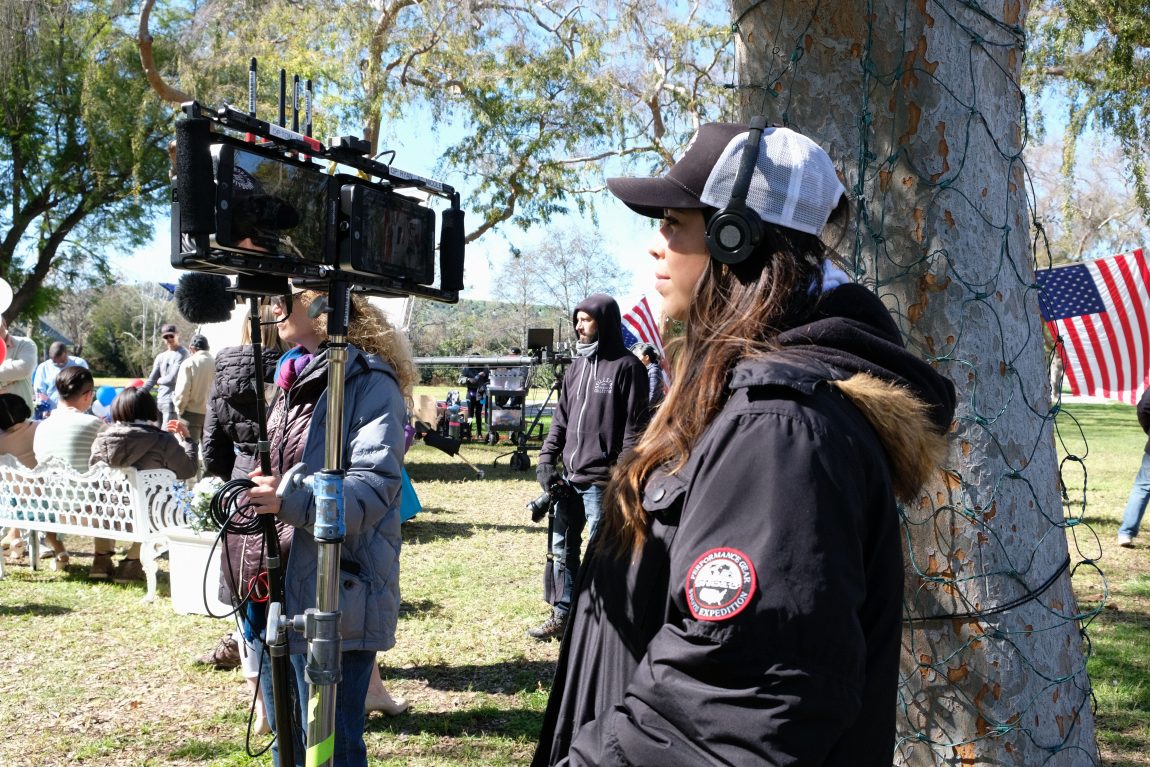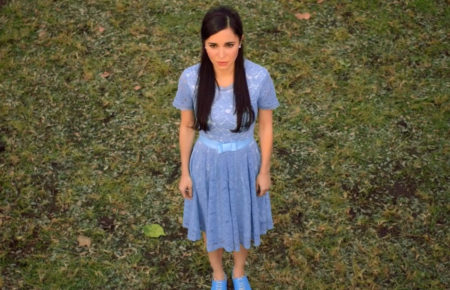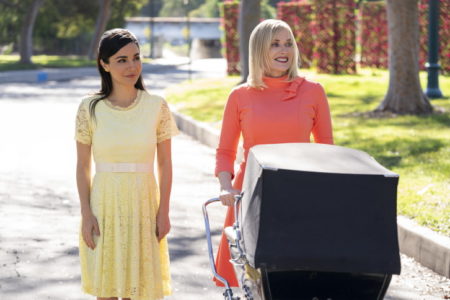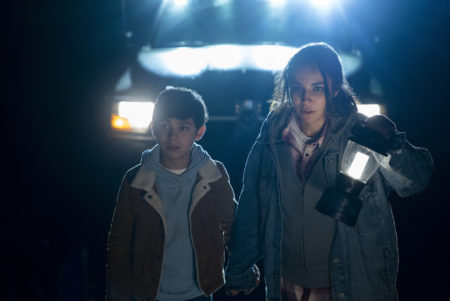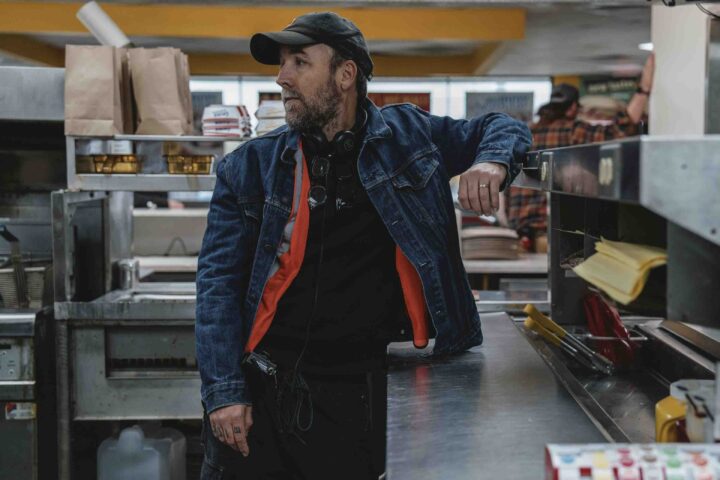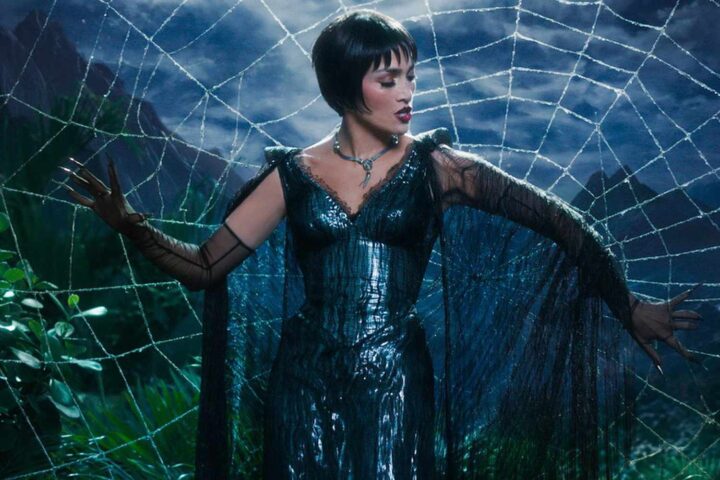You’ve got to hand it to Mexican-Canadian filmmaker Gigi Saul Guerrero. What the emerging talent has accomplished in her new Blumhouse picture Culture Shock, premiering July 4 on Hulu’s Into the Dark, took considerable brass, not to mention a keen understanding of genre as an exploration of social anxieties.
Directly confronting a perversion of the American Dream through the eyes of a determined immigrant who first faces a dangerous crossing and far worse upon arrival (timely, anyone?), Guerrero takes aim at notions of assimilation, small town oppression, government bad guys and yes, detention centers like you won’t believe.
And since Culture Shock is also a slick piece of entertainment, living at the intersection of social realism, satire and science fiction, Guerrero has a ball with a deft trio of distinct aesthetics, juggling multiple realities while somehow contextualizing each in the moment of right here, right now. Here we meet hard luck Mexican nationals, American benevolence run amok and conspiracies of forced assimilation, all coexisting in an unlikely, yet simpatico, amalgam of tones.
Keenly training her eye on American mores as only foreign filmmakers can sometimes do—see Martin McDonough’s midwestern allegory Three Billboards Outside Ebbing, Missouri, Lars von Trier’s savage small town indictment Dogville or even Jim Sheridan’s heartfelt immigrant drama In America, to name a few—Guerrero speaks to our current socio-political immigration travesty from the perspective of a Canadian-raised filmmaker, born in Mexico and whose family emigrated north for the fabled better life which so eludes her characters. And while her identity as a northern neighbor may posit Guerrero as an outsider artist in the States, Culture Shock couldn’t be more relevant to U.S. headlines or more personal for its filmmaker, shooting in East L.A. to authentically recreate the country of her birth.
I recently caught up with Gigi Saul Guerrero to chat about her ambitious new movie, our mutual love of genre films and how Culture Shock addresses how we are living this immigration crisis today, which for this writer is also personal, having raised an undocumented child through a tumultuous two decades of political football and blocked legislation eschewing compassion for people whose lives always hang in the balance. Why don’t artists confront these issues more often in film, I wondered? Of course, Gigi had the answer.
Lee Shoquist, ChicagoFilm.com: Culture Shock is a movie of right now; of this moment.
Gigi Saul-Guerrero: Yeah. It’s extremely relevant. As a filmmaker, whatever movies we make are to encourage a conversation. And in this case, a film like Culture Shock is to encourage a conversation to make the world better—not just America, but the world. Because what is happening with the border crisis is heavy stuff. When I first read the script it had a bit of that concept, but it was also a bit too vanilla. I was like, ‘If we are going to talk about it, now is the time to talk about it. We have got to talk about it.’
I was glad to hear that you are a genre fan because as you know, you can go far with any subject matter and change it to any crazy, wacky idea, yet keep it entertaining for people throughout. Because I personally cannot sit through what is on the news every night. It’s too heavy for me. I wanted to give people a film where they could let go, enjoy it and then, at the end, be reminded. You know?
What you said is very true. For example, if you look at Jordan Peele’s Get Out or Us, they are social thrillers addressing some very real societal fears. Thrillers have always done this. You get more latitude to speak about real things in a much different way.
Exactly. You can go in any direction, but at the end of the day the horror is the reality! That’s the horror.
Can you talk about the film’s structure? I got a real kick out of it. The first third is realism and we don’t know where the movie is going. Well, maybe we think we do, but we are wrong. It starts as a gritty survival drama about crossing the border. Then suddenly we are in a sort of satiric Americana.
Yes, I like to call it a Pleasantville gone wrong!
I thought of Pleasantville also! And then the third section, which is a genre one might call the mad scientist formula, or whatever you want to call it, looks and feels distinctly different from the others. I thought that was very cool.
Oh, thank you so much! I really wanted that feeling. And it’s not just the feeling of culture shock. When I moved from Mexico to Canada, I felt that change of worlds and people would always ask me, ‘Which one do you prefer?’ I can’t compare. We are talking two worlds here. And that always resonated with me, and I wanted that feeling for our characters—just different worlds, literally! I just really wanted that feeling of, ‘Wow, I am living the American Dream, but it’s too perfect. There is something too perfect about this side of the border that is…off.’ I was so excited to tackle that in my own way, from my own experience.
And then of course the worlds start to merge; they are not so distinct later. We are in one, then the other, then both.
I’m so excited that you noticed that. We wanted to go as far as changing the aspect ratio in the worlds.
That’s right.
Many people who have seen it haven’t noticed that it changes! It goes wider in America. And we wanted to have little details like that to really make you feel what the characters are feeling.
Yes. Can you talk about Martha Higareda’s performance? She’s terrific. This sort of conceptual film works well when the lead believes in the material and plays it straight. There is no sort of winking or awareness of the convention of it. She’s playing it passionate and straight and true. I felt that even in the more fantastical elements later, where she’s in the government facility. I really felt she believed it all the way.
Amazing. She’s incredible. Martha has auditioned for border crossing films a lot, and the same with Richard (Cabral), who plays Santo. And they said, ‘This is the first border crossing film in a long time that is different.’ And I could sense that excitement from their side; that enthusiasm to do something so different and so relevant. I was really excited to work with a Mexican cast; not just Latinos but a Mexican cast, and the freedom to be so Mexican in our language and our mannerisms and all that. And that to me was so beautiful, because I got to direct them in Spanish and then go back to English for the crew. You can tell how genuine the performances are and it all goes very organic together.
I also loved how you treat the idea of assimilation into American culture and how Martha approaches Richard, and of course Ian Inigo as her young charge, and tries to get them to speak Spanish again. It’s a very pointed thing she is doing. It is fantastical in the context of Culture Shock’s alternate reality, but this whole idea of assimilation and losing your culture and language really resonates. And then the pizza eating scene, for example! (laughter) That scene is very effectively speaking to this idea of losing yourself and getting a laugh at the same time.
Exactly. Yes. You said it perfectly. I really wanted the characters and audience to feel what it’s like to have a different culture shoved down your throat and go through that without a choice. And later in Culture Shock, there was a moment to go horrifying and visceral and nasty; to be shoved down by these machines, forced to accept another culture without a choice. To me, that was very scary.
I feel very fortunate that for me it wasn’t like that—it was more that my parents just wanted a better life for us in Canada. But with what is going on today, it is just shoved in you and you don’t have the choice. And how these kids are being kept in cages and separated. They don’t have the choice! It’s brutal! So to me it was so important to talk about that. You said it perfectly. I think you answered your own question, really, and I just added to it!
I’ve been watching Barbara Crampton in the movies for years and met her on occasion. She’s a great lady.
Oh, god bless Barbara!
This is a great role for her, and she runs with it.
Oh, yes!
And without giving too much away, it’s hard to find the right calibration for a character like that. It’s largely symbolic. Taking it too far could make it a real cartoon.
Very much! Exactly. What you just said is what I kept seeing in all the auditions. Barbara was the last audition. And every person I was auditioning was exactly what you said—too cartoony. I didn’t feel that creepiness or unrealism. Betty is tough role! I think it is the hardest after Martha’s. But I just remembered, ‘Wait a second. What if we get Barbara?’ I met her at the Mórbido Film Fest and we stayed in contact. I’m like, ‘She’s a little young for the role but she could do it.’ She doesn’t live in L.A., so she sent in a self-tape, and oh, honey! Barbara just sent the best tape and convinced everybody!
Will you put that audition tape on the Blu-ray?
Oh yeah, that’s a great idea! She even filmed it on her phone and was like, ‘Sorry, there’s not enough light.’ It was so good, regardless. It was like, ‘Barbara, you are it!’
She is the nicest person. Once at a convention I went to dinner with her and a few others. I mentioned to you earlier that I was involved for years in an immigration situation that was quite difficult, and at that time I told her about it, and I remember her being so supportive. Then I saw her a few years later and she asked me how it turned out.
That’s her. Very special. Every day on set she was such a good mom—like a mother figure to a lot of people. She really makes it fun to be on set. She is so respectful and really breaks down scripts on another level. I personally have not worked with another actor like Barbara, that thinks about all the other characters, even in scenes she is not even in. She is not even in the first half of the film and she was really into it. To me, that is such a professional, and I can’t wait to keep working with her and with all of them—the whole cast was amazing!
Let’s talk about the laboratory scenes. It’s very hard to watch them and not think about what we talked about a minute ago, in terms of what is happening at the border with cages, incarceration and concentration camps.
Exactly.
And I am sure there are many things going on there that we don’t know about in these government facilities. It’s impossible not to think about them when we see these experiments happening in the movie. You even have some lines, and I’m paraphrasing, about children being the first to go…
Yes. ‘They always insist on dying…’ There are a lot of quotes. I am so glad that you saw and noticed those things. There are a few lines that express exactly what we are going through. One of my favorites is, ‘I’m not paying you to give them the American Dream. I’m paying you to keep them out.’
That’s right. Quite something.
I was like, ‘That’s it. That’s the line. That is the movie that we are making here.’ And that has lasted since the first draft of the script.
Of course it’s interesting that it comes from the character of a bureaucratic mad scientist who later becomes a governor in the July 4th sequence, which is very believable given some of the GOP congresspeople today. There are many surrogates in real life, right?
Yes, definitely.
The look of those laboratory sequences I thought was great. It reminded me of James Cameron crossed with The Matrix, actually.
Oh, wow! I’ll keep that compliment for the rest of my life! Thank you!
It was so fun—the flashing green lights, handheld, canted angles, the editing. It had that feeling of a good science fiction thriller. And it’s enjoyable to watch because we’ve already had gritty realism and a sort of fractured satire of America, and then we get this.
Yes, the sci-fi element.
The movie is delivering many different styles and tones.
Sometimes that can be risky. If you do a mash of things it can get muddied. But with this one, I really wanted to split that cake with different flavors. Thank you very much! I don’t know what to say to that!
Yes, it surprised me. At first, I thought we were getting a border crossing film like Cary Fukanaga’s Sin Nombre…
That’s exactly what I said! Man, you are great! I said that in my pitch! I said, ‘This movie is going to begin like Sin Nombre, and everybody will think you are about to watch another Sin Nombre’—a sequel, prequel or whatever. But they end up in a Pleasantville gone wrong. That was my pitch! Exactly that!
What was the best day on the job for you?
I think the best day was creating Mexico.
Where did you do that?
East L.A. in Boyle Heights. I’m not from L.A. and don’t know anything there, but it just felt like we were creating something so personal. And if you want to get to the nitty gritty, sure, I loved all the gore scenes we filmed because that’s my fun! But creating Mexico and the marketplace, for example, was so exciting to share with everybody; all the Mexico scenes and the dialogue and relationships. I just really felt like I was doing something right and had that opportunity to share a part of me with everybody.
You’re teaching people something in a way that’s not teaching, per se. You are putting it in the context of entertainment. Are you surprised that more artists today are not doing that? We have this crisis happening in our country, which we’ve been talking about, and we are getting almost no artistic response to it.
Because it’s risky to talk about it. You don’t know if the person sitting next to you feels the same or not. At first, I was like, ‘I don’t know if people who support these decisions of the government- what are they going to say about it?’ But at the end of the day I said, ‘Screw it. It’s time.’ I think we will slowly get there, to talk about these things and put them in films. But I think for American filmmakers—and I’m speaking for them because I’m not American but can assume—it’s tough because you probably know a lot of people who feel both ways. So I can only imagine how tough that must be. Hopefully more of these conversations can be encouraged and talked about.
Well, it all landed on me very clearly in the film and I enjoyed the picture’s conversation, and ours.
Thank you! You broke it down so great! Thank you so much.
